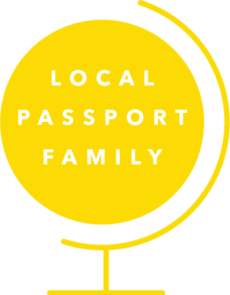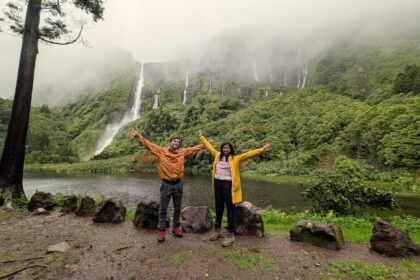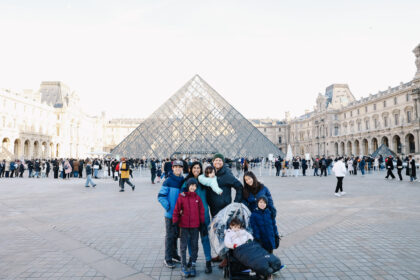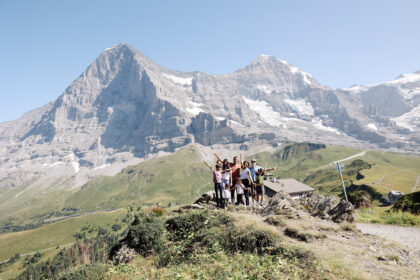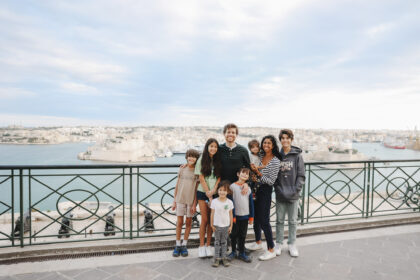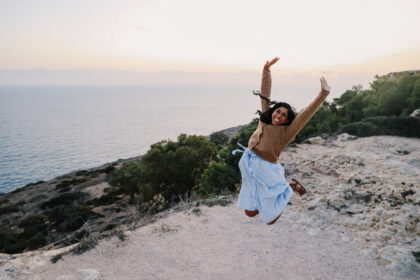Visiting Virgin Islands National Park with kids is definitely a once in a lifetime experience! This was a special trip for our us, and Virgin Islands with kids was a hit with the whole family. We’ve loved finding the best things to do in the Virgin Islands!
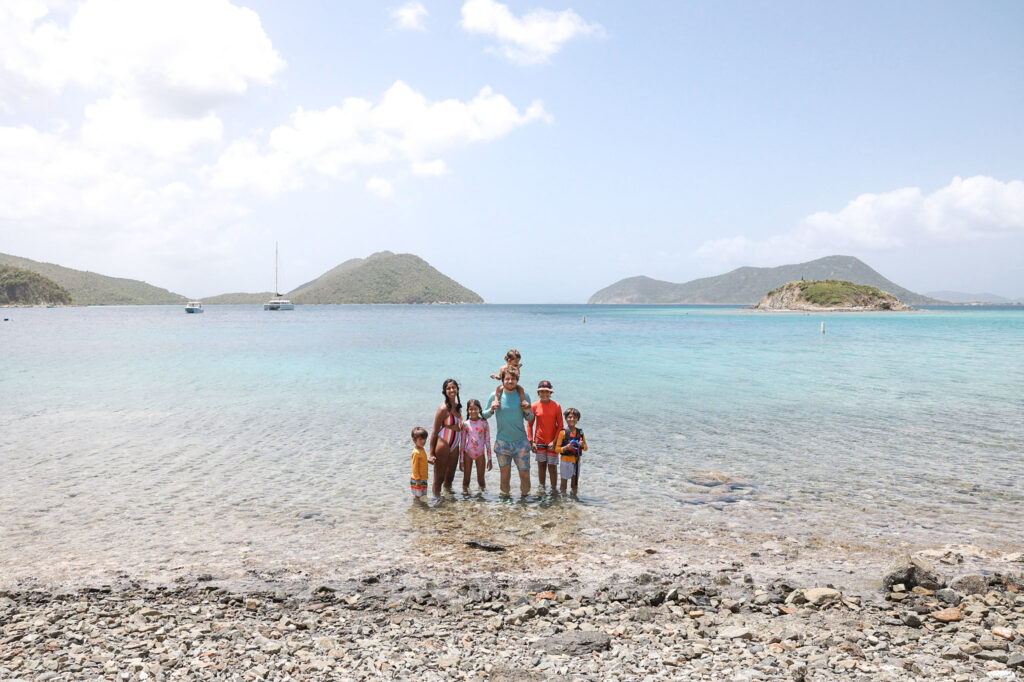
Learn About Virgin Islands National Park
Before we visit a national park, our family loves learning about it! It helps us enjoy it more and appreciate the people who have stewarded it well before us. We love learning about the indigenous history, as well as about wildlife and ecosystems.
Here are a few ways to learn about the park either before a visit or as part of a Virgin Islands virtual tour!
Virgin Islands National Park History & Natural Features
- Humans first arrived in the Virgin Islands from South America about 2500 to 3000 years ago. They likely traveled to the Virgin Islands from South America and made short trips from island to island as they made their way north.
- Starting in the early 1600’s, European slave ships transported millions of African people from their homes in Africa to a life of bondage in the Caribbean. Beginning in the early 1670’s, The Danish West India company established a slave Market in the port of Charlotte Amalie, on St. Thomas.
- Enslaved people resisted their bondage from the earliest days of their arrival. Resistance took many forms, but the most common was marooning. Marooning is a practice in which enslaved people escaped from the plantation into thick vegetation of the hillsides.
- In 1718 the Danes established the first European settlement on St. John, and people began to clear land for plantation agriculture (mostly sugarcane and cotton), cut timber, and introduce nonnative plants and animals. As much as 90% of the island’s original vegetation was destroyed.
- In 1834, abolition came to the British Virgin Islands. After emancipation in the Danish West Indies on July 3rd, 1848, the formerly enslaved people of St. John abandoned life on the plantations. They developed new industries such as the production of bay rum oil and charcoal.
- Virgin Islands National Park contains some of the most diverse dry tropical forests in the Caribbean with more than 700 native or naturalized plants.
- The only mammal native to St. John is the bat. Some bat species are important pollinators of many floral species on the island as well as important seed dispersal agents for many species of fruit bearing trees and shrubs.
- (Source) (Source) (Source) (Source)
USVI Wildlife and Conservation
Virgin Islands National Park is rich in natural resources. There are 140 species of birds, 302 species of fish, 7 species of amphibians, 22 species of mammals and 740 species of plants inhabiting the Island.
Nonnative mammals are common on St. John. Donkeys, goats, and mongoose were introduced by humans. You may meet some of these animals on the road or at the beach. Please remember that these are wild animals; do not feed or try to touch them. Further, these animals often use roadways or paths along the road. Be cautious as you navigate the island by car. For more information about nonnative species in the park, click here.
Sea Turtles of Virgin Islands National Park
There are seven species of sea turtles in the world, and three of these inhabit the waters of St. John. The two most common are the green and hawksbill turtles, while the leatherback is rarely seen. Sea turtles spend most of their lives in the water only coming ashore to nest.
Sea turtles face several threats such as recreational boating, commercial fishing, marine pollution, habitat modification, and poaching. Due to these threats, and more, all species of sea turtles are listed under the Endangered Species Act. Anyone caught touching, riding or disturbing a turtle will be subject to fines up to $5,000 and imprisonment for up to 6 months.
How can you help protect sea turtles?
- Never touch or chase them! By touching, chasing or riding them, visitors disturb their eating, resting and even nesting habits.
- Don’t litter. Remember some turtles mistake balloons, and plastic for food.
- Don’t leave deep ruts, holes or tracks in the beach. The baby sea turtles get stuck in them when they hatch attempt to reach the sea.
- Prevent light from shinning on beaches.
- Do not drive on beaches. You risk crushing eggs.
- Never disturb feeding or nesting turtles.
- Never buy or sell sea turtle products.
Check out the North Florida U. S. Fish & Wildlife page on how you can help protect sea turtles.
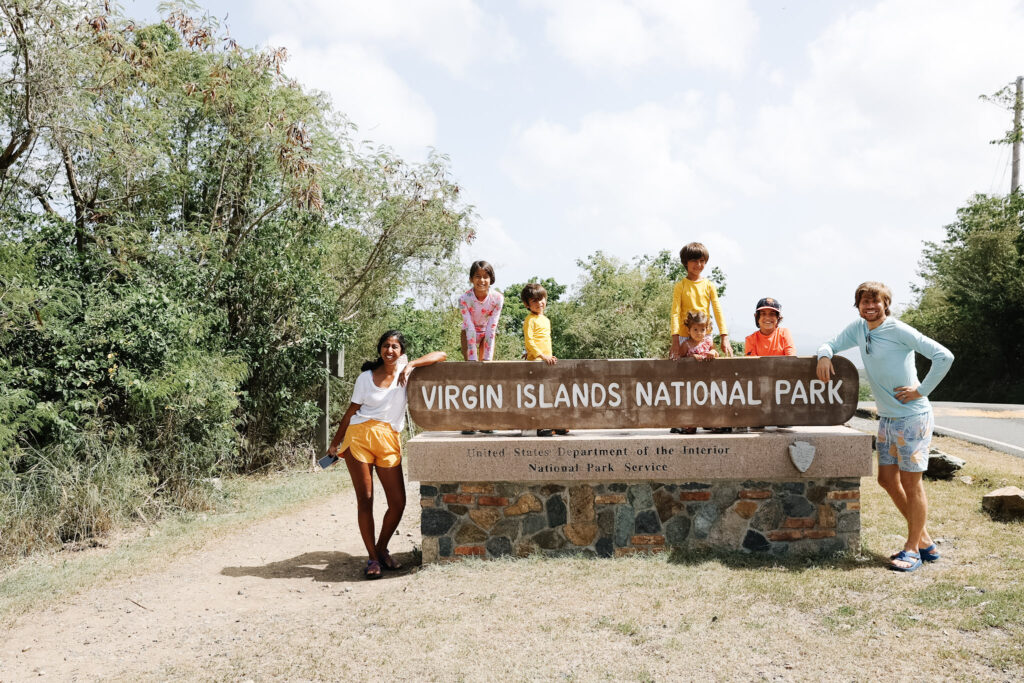
Virgin Islands Indigenous History
- The islands were inhabited at different times by the Taíno, Arawak, Ciboney, and Kalinago peoples. These tribes were maritime peoples who subsisted primarily on hunting and gathering and used dugout canoes for transportation and fishing.
- The Taíno people spoke an Arawakan language, but they developed a culture that was easily distinguishable from that of their mainland ancestors, who also spoke Arawakan.
- The Taíno grew crops like cassava, potatoes, and corn. They built communal villages, used stone tools, and practiced a complex religion based on ancestor worship complete with priests, rituals, sacred relics, and more.
- They developed farming methods that required very little time and effort to maintain, allowing ample free time. In this free time, they developed complex religious ceremonies and games of skill, like Batéy. Batéy is a ball game played on a small court. Two teams attempt to drive the ball past the other team’s backline without using their hands.
- Each Taíno village had a chieftain, known as a “Cacique.” The Cacique was not only the political leader of the community, but he was also the spiritual leader.
- At the time of Christopher Columbus’s exploration in 1492, the Taíno were the most numerous indigenous people of the Caribbean and inhabited what are now Cuba, Jamaica, Haiti, the Dominican Republic, Puerto Rico, and the Virgin Islands.
- By 1550, the Taíno were close to extinction, many having succumbed to diseases brought by the Spaniards. Taíno influences survived, however, and today appear in the beliefs, religions, language, and music of Caribbean cultures.
- Although elements of Taíno culture remain strong in parts of the Caribbean, it wasn’t until 2021 that Gov. Albert Bryan Jr. signed a proclamation recognizing the Guainía Taíno Tribe of the Virgin Islands. Indigenous People’s Day in the Territory is October 11th.
- (Source) (Source) (Source) (Source)
Featured Virgin Islands Picture Book: Looking for a Jumbie

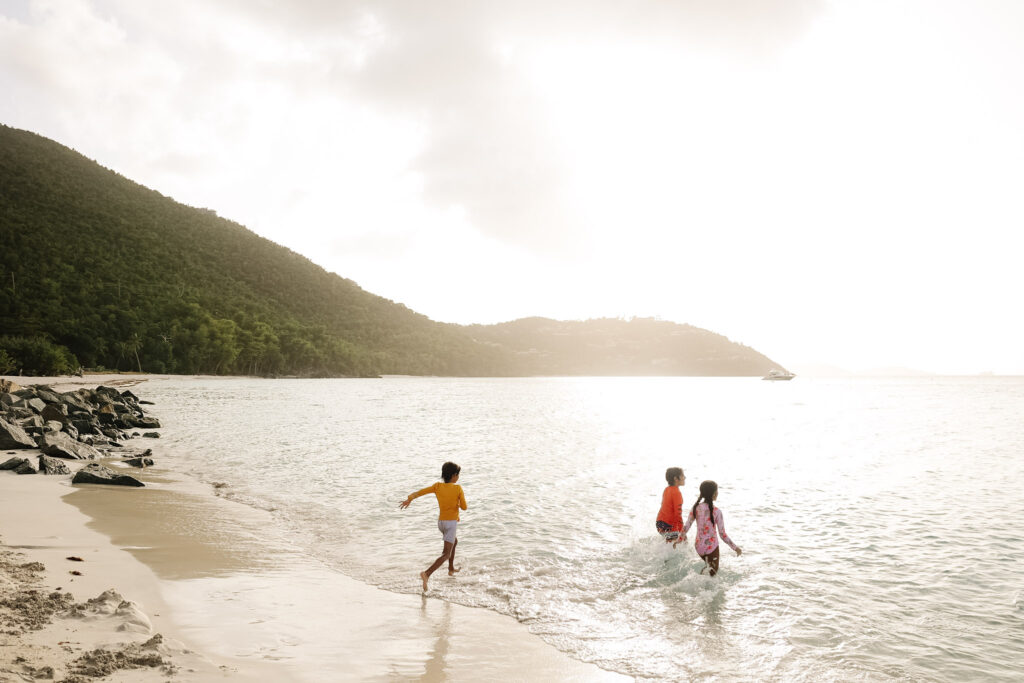
Virgin Islands Packing List: What to Pack For a Virgin Islands Family Vacation
Virgin Islands National Park Packing List
- Carry-all backpack – this is our favorite grown-up pack to carry essentials for a day hike
- Kids’ Hiking Backpack – our kids absolutely love these 18L hiking backpacks. They’re perfect as a day pack or for travel – they hold a ton, are sturdy, comfortable, and have a spot for a water bladder. They even work really well on my short torso and I alternate between one of those or this women’s day pack. We also love this 12L kids day hike backpack for younger kids.
- Backpacking Backpack – if you’ll be doing any overnight adventures, we really love this 40L pack for overnights.
- Sun Protective Gear
- Sunscreen: I love this kind for kids – it’s mineral-based, provides great protection, great for sensitive skin, and rubs in easily. This is my favorite facial sunscreen for myself (use code LPF15 for 15% off). A reminder than reef-safe sunscreen is especially important when visiting the Virgin Islands.
- We always pack along rash guards for the whole family. We’ve found some great, affordable ones HERE and HERE.
- Sturdy shoes
- I like these hiking boots for women and men, and these hiking sandals for women and men.
- I’d recommend a pair of sturdy hiking sandals when exploring Virgin Islands with kids – they’re multifunctional for the water and also any hiking adventures (including on rocky shores). My kids love these hiking sandals (also available HERE).
- First aid kit and my favorite bandages
- Insect Repellent
- It can definitely get buggy around here, especially in the summer. We love this deet-free repellent (use code LPF15) and this Picardin-based bug repellent in areas that don’t have a high prevalence of disease-carrying mosquitos (we use Deet in Zika/dengue/malarial areas).
- Quick-Dry Towel
- We like to have a couple of our favorite quick-dry towels on hand in case of rain or any spills or for the beach. I also like THESE.
- Hat
- This is my favorite hiking hat and my favorite hat for babies.
- Camera equipment
- Water/snacks
- We love this water bottle and this water bottle for adults.
- This hydration backpack for kids is a favorite. (Also available here.)
- My older kids LOVE this water bottle.
- This and this are our favorite water bottles for toddlers.
- Child hiking carrier – We love having a carrier to pack along a baby or toddler when visiting Virgin Island with kids. This is our favorite backpack hiking carrier for visiting Virgin Islands with toddler that also has plenty of room for snacks and even our big camera. If we’re not doing tons of hiking, I absolutely love this lightweight, travel-friendly packable baby carrier. It folds into a little pouch, and also dries in a flash – really helpful when visiting the Virigin Islands with a baby.
Reef-Safe Sunscreen at USVI
Reef-safe sunscreen is a must at Virgin Islands National Park! Reef-safe sunscreens are free of oxybenzone, octinoxate, and octocrylene. Recent studies have shown that chemicals in sunscreen, like oxybenzone, can be harmful to coral reefs. Corals are tiny soft-bodied animals called polyps. Their food is provided by photosynthesis from the algae that lives within the polyps. The chemicals in sunscreen can cause the corals to become ill and die.
As of March 2020, sunscreens that contain oxybenzone, octinoxate, and/or octocrylene are illegal in the US Virgin Islands. Using these products could result in a $1,000 fine for the first offense and another $2,000 fine for the second offense.
Check out this reef safe sunscreen guide!
Baby Gear Rentals
Traveling with baby and toddler equipment can be cumbersome and expensive. St. John has a baby and toddler equipment rental service on island. They deliver directly to your accommodation and offer cribs, cots, bassinets, monitors and more! Check out Island Baby here.
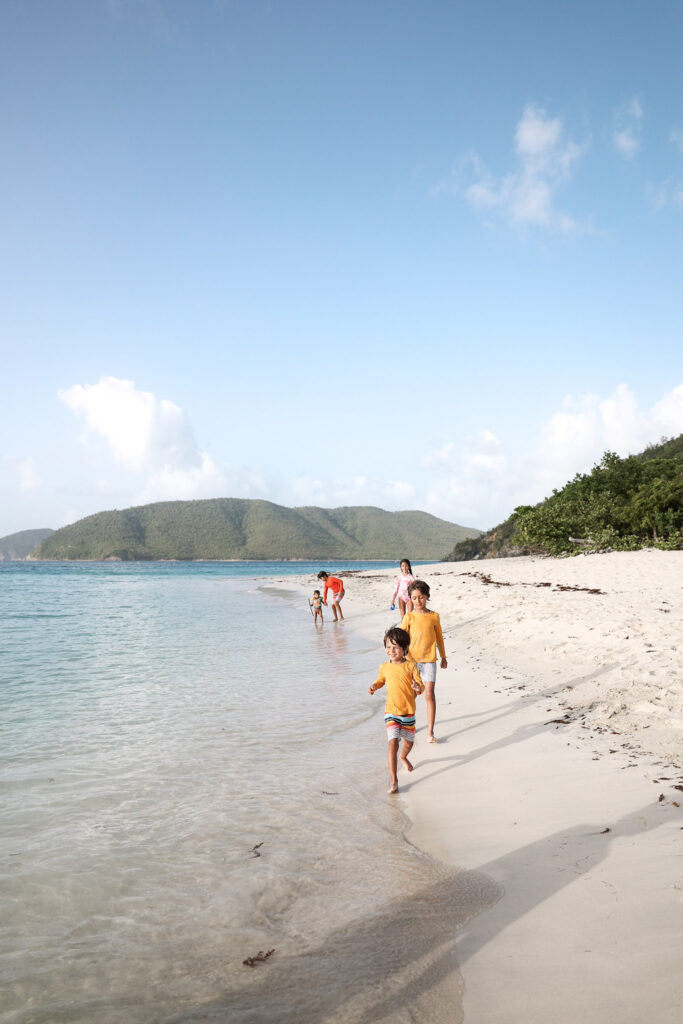
How To Get to Virgin Islands National Park
There are no airports on St. John, so you must fly to St. Thomas Cyril E. King Airport and travel from there.
- From the airport, rent a car or take a taxi to Redhook, St. Thomas.
- From Redhook you can take a car barge to St. John or the people ferry.
- Once on St. John you can easily walk from the ferry terminal to the Visitor Center.
How Many Days Should I Spend at Virgin Islands National Park?
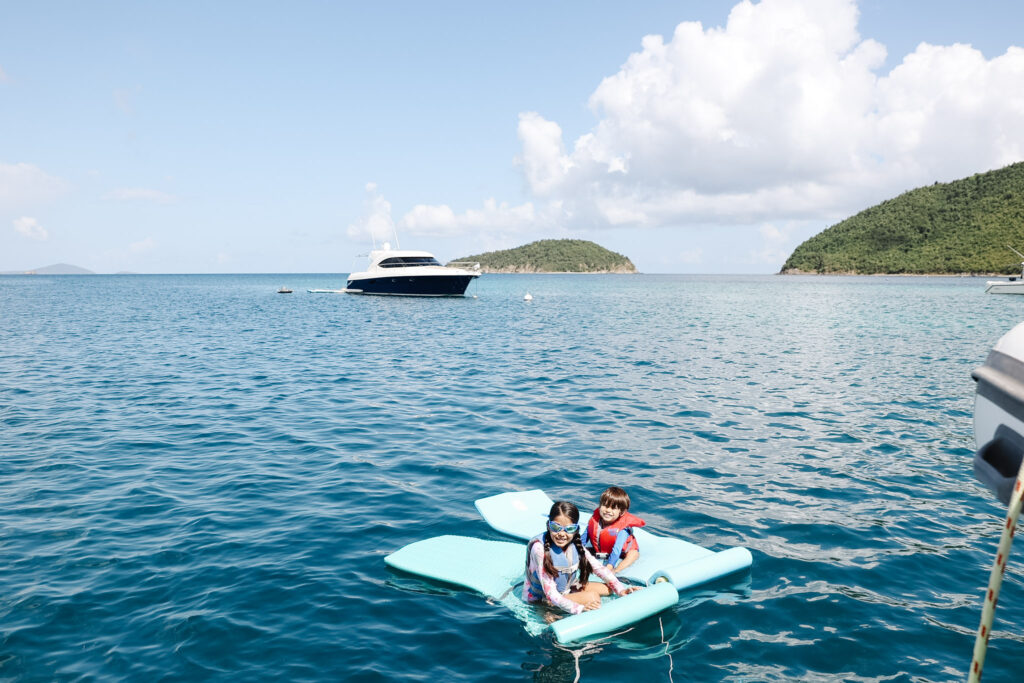
Where to Stay Near Virgin Islands National Park: Virgin Islands Lodging for Families
Camping in Virgin Islands National Park
Virgin Islands Lodging with Kids
- Coconut Coast Villas
- Elysian Beach Resort
- Casa Azul
- Sapphire Beach Resort
- Villa Nautilus
- Concordia Eco Resort
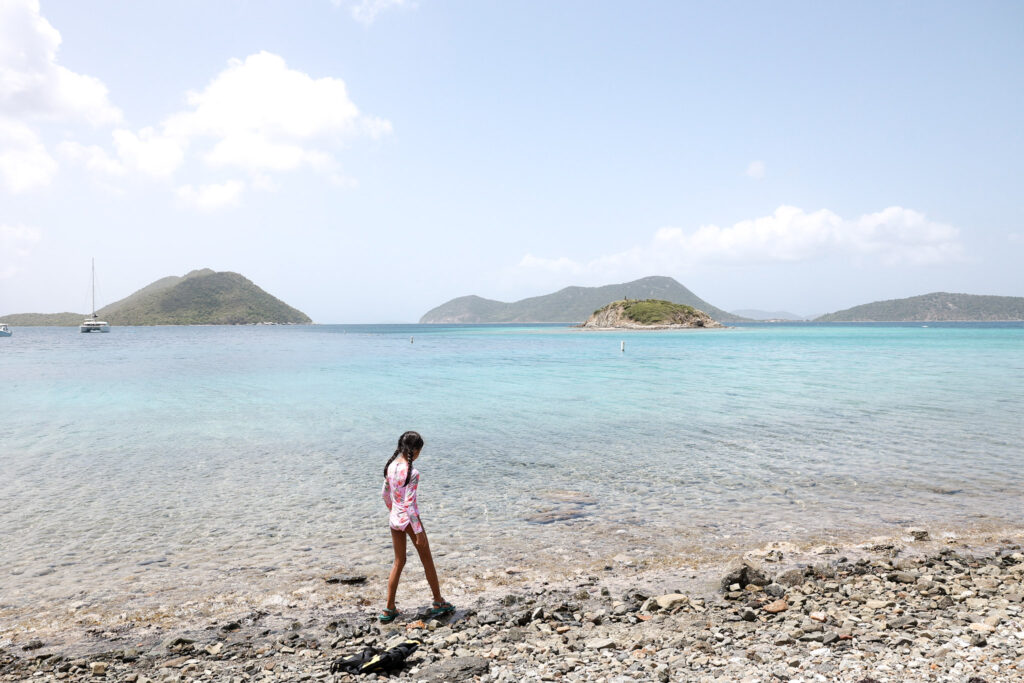
Where to Eat near Virgin Islands National Park
Eating in US Virgin Islands National Park
There are a few spots to grab a quick beverage or bite to eat while in the park. These include the Trunk Bay Café and Bar at Trunk Bay, and the Rain Tree Café at Cinnamon Bay Beach and Campground. At Cinnamon Bay Beach and Campground, meals are served in an open-air dining hall and grab and go food and beverage items are also available in the Cinnamon Bay food truck near the beach. Or grab food at a grocery store in St. Thomas and picnic on the beach, which is what we did!
Eating on St. John
- The Banana Deck
- The Lime Inn
- Baja El Sol
- Irie Pops
- Sun Dog Cafe
- St. John Brewers
How to Get Around the Virgin Islands: Virgin Islands Transportation
The safest way of getting around the park and the Island is by vehicle. Bicycles are not recommended due to steep, narrow and winding roads. You can walk to the Visitor Center from the ferry, but a vehicle is recommended for exploring the rest of the park.
And here is a complete post about traveling with car seats. These are our favorites by age:
- Favorite Infant Car Seat For Travel Available at: Amazon, Target, Walmart
- Favorite Convertible Car Seat For Travel Available at: Walmart
- Favorite Booster Restrain Vest For Travel Available at: RideSafer
- Favorite Booster Seat For Travel Available at: Amazon
Best Time to Go to the Virgin Islands: Virgin Islands National Park Weather
While the weather tends to be warm and mild in the Virgin Islands, there can be some seasonal changes. December – April tends to be a peak time as the weather tends to be dry and warm. April through June also tends to be mild and dry. July through October usually gets quite warm and is hurricane season so is not typically recommended. That said, we took a chance and visited in early September and had lucked out with absolutely gorgeous weather, warm waters, and lower flight/accommodations costs. We booked a last minute trip and checked the weather just a week before and it looked okay, so we decided to go for it. I’m so glad as we had an amazing time with fewer tourists!
Top Virgin Islands Checklist of the Best Things to Do in Virgin Islands National Park
- Trunk Bay Viewpoint, Beach, & Snorkeling
- Hike Cinnamon Bay
- Drive North Shore Road and stop at overlooks
- Visit the Annaberg Sugar Plantation Ruins
- Hike to Waterlemon Cay & snorkel
- Hike to Ram Head Point
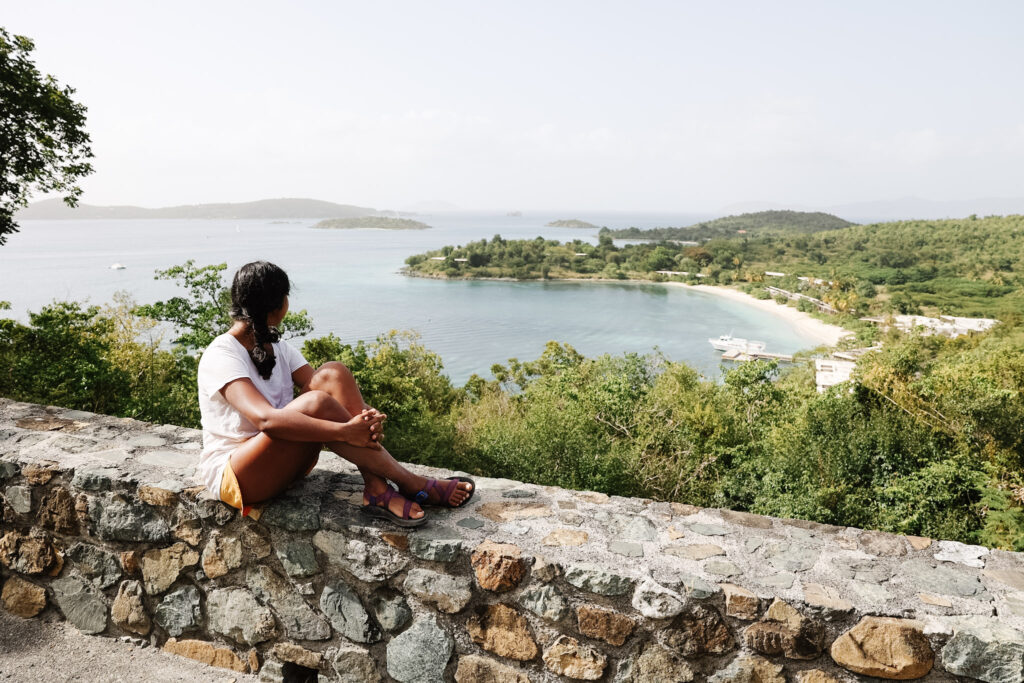
Best Things to Do in Virgin Islands National Park: Virgin Islands National Park Itinerary & Unique Things To Do in Virgin Islands National Park
1. Snorkeling in Virgin Islands
Nearly half of Virgin Islands National Park is underwater, so one of the best ways to explore the park is by getting in the water. Snorkeling in Virgin Islands National Park might just be the best snorkeling I’ve ever experienced in my life, so definitely prioritize doing this if at all possible. The park offers wonderful snorkeling opportunities from mangrove shorelines to reefs. Check this page for extensive information about snorkeling in Virgin Islands National Park. Here are a few spots to try snorkeling in Virgin Islands:
- Cinnamon Bay – pristine and beautiful
- Trunk Bay – often voted one of the most beautiful beaches in the world – $5 entrance fee
- Waterlemon Cay – a short hike to get to this quiet cay is well worth the spectacular snorkeling
- Hawksnest Bay – coral reefs
- Maho Bay – best for sea turtles
- Salomon/Honeymoon Bay – finger coral colonies
- Francis Bay – great for beginners
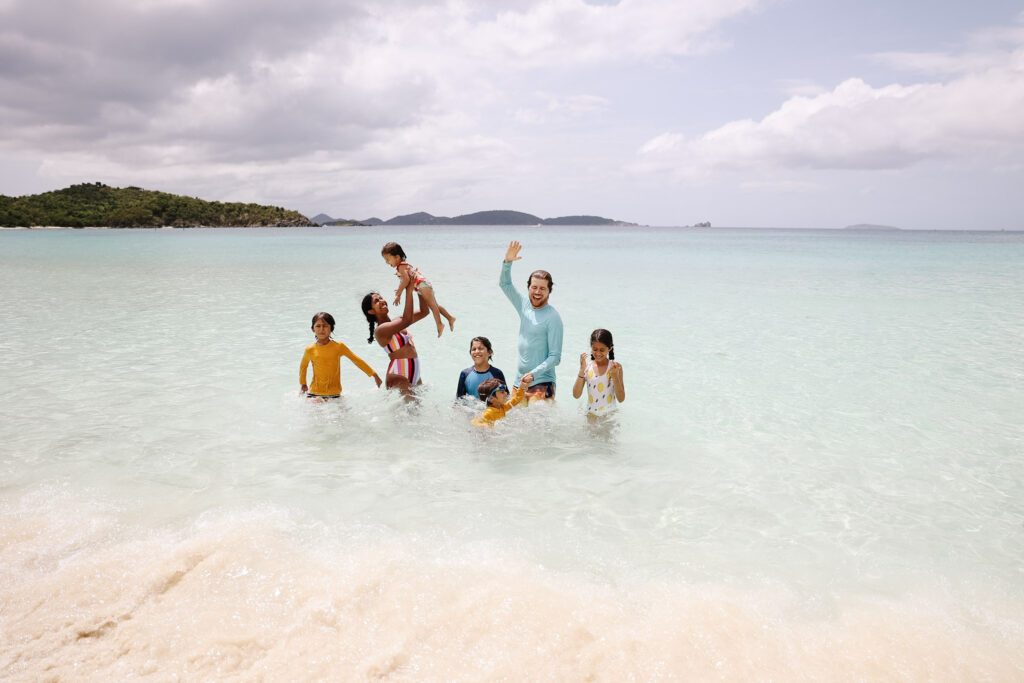
2. Learn About the Island’s Sugar Industry
The island has several sugar plantations and sugar mills that provide important historical context for the park. Here are a few sites to include in your visit:
Annaberg Plantation
Annaberg Plantation was largest sugar producing estate on St. John. At the height of Annaberg’s production, over 600 enslaved persons lived and worked the plantation. The Leinster Bay waterfront, upon which Annaberg was built, is now part of the National Underground Railroad Network to Freedom. There are remains of the mill, factory, and enslaved peoples’ quarters on site. You’ll also have a beautiful view of Waterlemon Cay from here. Docents are available on site weekdays from November until April.
If you cannot visit in person, explore a 3D view of Annaberg sugar plantation. You will find a virtual exhibit, lesson plans, and other resources at this link.
Catherineberg Plantation
Catherineberg, was another sugar plantation and factory is located on Centerline Road overlooking Cinnamon Bay. Like the Annaberg and Cinnamon Bay sugar mill operations, Catherineberg’s enslaved labor force produced valuable sugar for market. Visitors can drive the rough road to Catherineberg to park near the ruins or park at the base of the hill and hike up. It is not as developed as Annaberg, but much of the windmill and the boiling house remain.
Reef Bay Sugar Mill
The Reef Bay Sugar Mill can only be reached by hiking or by boat. This factory was the latest operational sugar mill on St. John, with operations having ceased following a fatal accident in 1908. The remnants of the steam engine are still largely intact. Signage throughout the factory provides visitors with information on the how the factory operated.
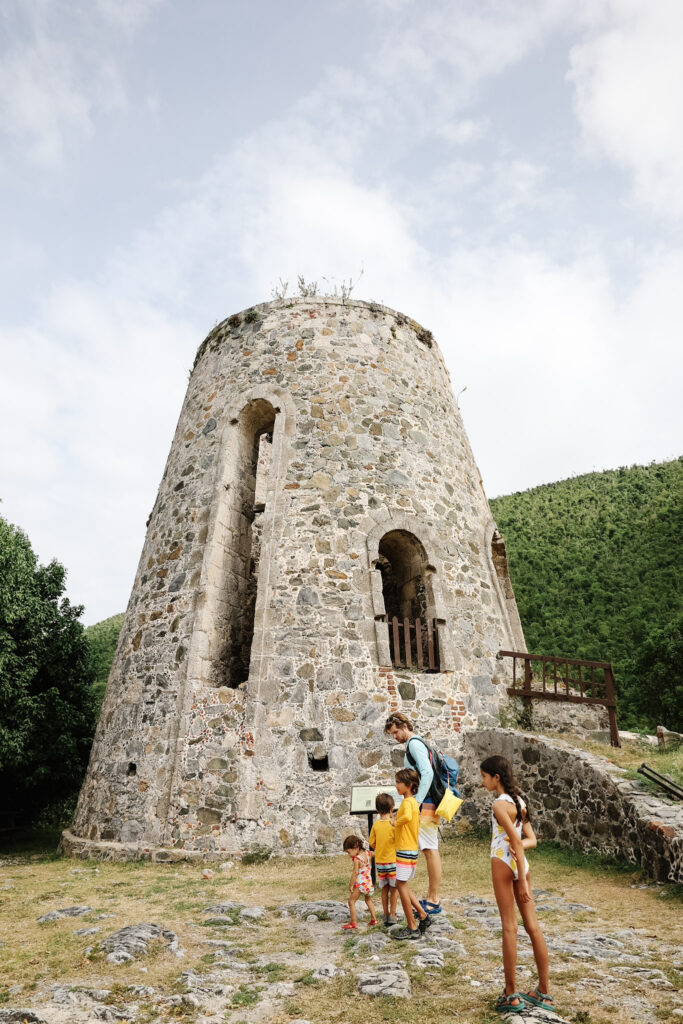
3. Virgin Islands Ranger-Guided Tours
Virgin Islands National Park has a number of programs with rangers, including hikes, astronomy tours, and even safaris. Most of the ranger-led programs at Virgin Islands National Park are facilitated by Friends of Virgin Islands National Park. The Reef Bay Trail is open for self-guided hiking, but if you’re able to join the ranger-guided hike it’s a great way to learn more about the history of the area.
4. Take A Virgin Islands Boat Tour
Since the park is so water-based, taking a boat tour is a perfect way to experience the gorgeous blue and access some places harder to reach by foot. This snorkel & swim trip would be a fantastic boat excursion, or this full-day all-inclusive would be a great choice for a family or a group. A private sail gives you more flexibility – we absolutely loved our family’s full day adventure on a catamaran!
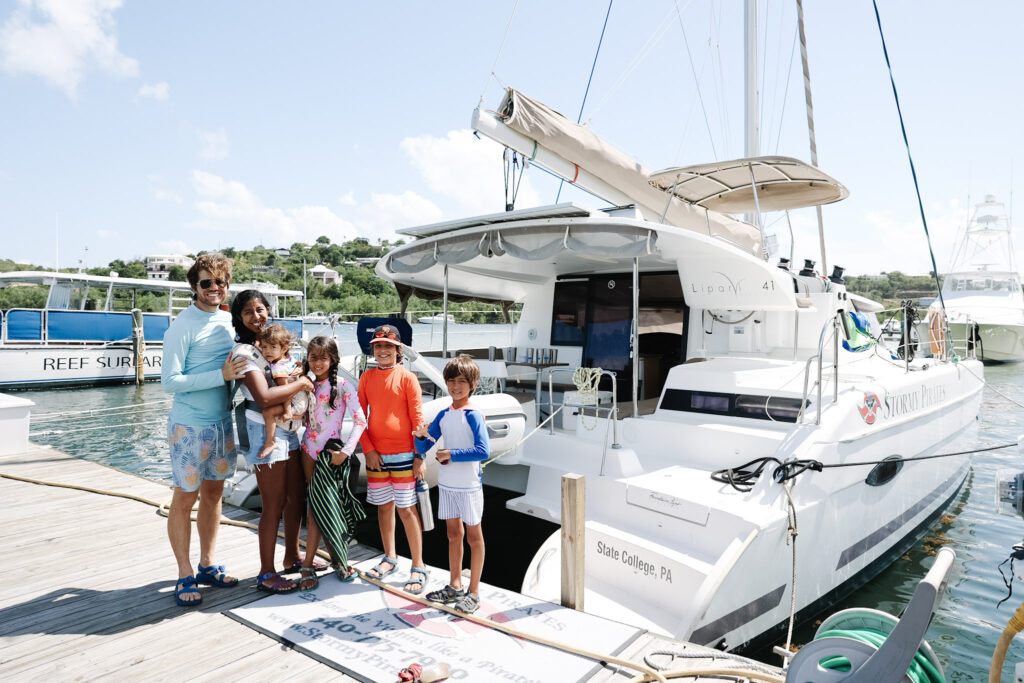
5. Fishing in Virgin Islands
Depending on the season, you may have the opportunity to try your hand at fishing in Virgin Islands National Park. Species like Caribbean Spiny Lobster can be fished all year, but most other species are only open seasonally, Some species require a permit to fish. Be advised, no fishing of any kind is allowed in Coral Reef National Monument. For more complete details around seasons and permits, visit this page.
6. Junior Ranger Program
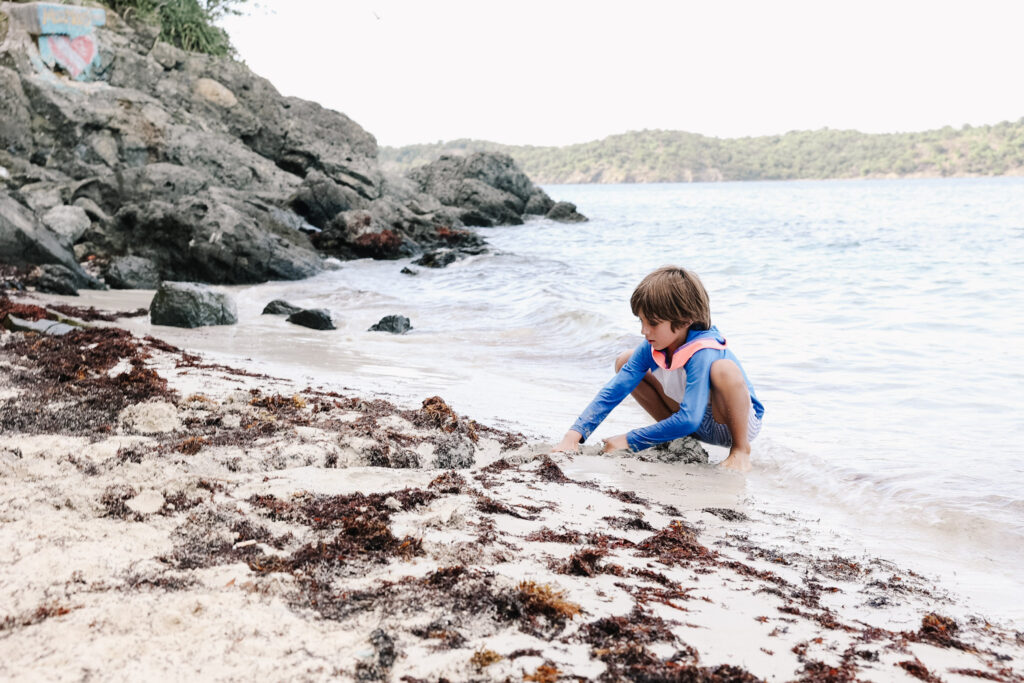
7. Hike A Virgin Islands Trail: Best Hikes Virgin Islands National Park
- Reef Bay: highly recommended, this strenuous trail brings visitors to the Reef Bay Sugar Mill ruins, along with ancient rock carvings, the island’s tallest trees, and a waterfall.
- Johnny Horn: another strenuous hike, but this trail leads to some of the most spectacular views on the island.
- L’Esperance: just over 5 miles round trip, this trail follows a historic Danish road passing ruins of some of the earliest plantations established on St. John. You’ll also see the island’s only baobab, a sacred tree species that was brought to the Caribbean by enslaved Africans.
- Cinnamon Bay: this trail takes visitors through the ruins of the historic Cinnamon Bay Sugar Plantation. The nature loop is an easy 0.5 mile hike. For a more adventurous hike, try the strenuous 1 mile Cinnamon Bay Trail which begins east of the ruins.
- Waterlemon Cay: this short hike ends at a quiet and beautiful cay with incredible snorkeling
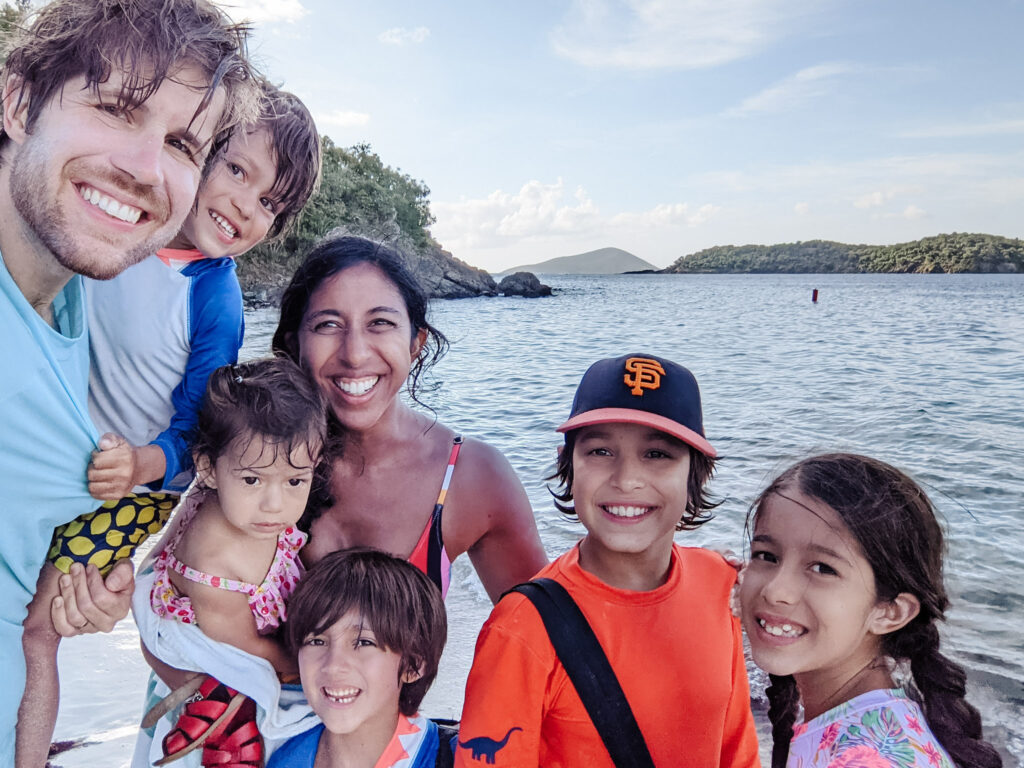
8. Virgin Islands Beaches
There are five beaches in the National Park, and each brings something unique. Picnic areas are located on several of the beaches and offer tables and grills. Here’s a bit more about each beach to visit:
- Trunk Bay Beach: one of the most beautiful beaches in the world. There is an underwater snorkeling trail and a short bit of beach for walking with accessible paths and ramps. Amenities include snack shack, bar, snorkel gear rentals, a beach shop, restrooms, and showers. There is a day-use fee of $5.00 per person.
- Cinnamon Bay Beach is the longest beach in Virgin Islands National Park, and is the site of the park’s campground. You’ll find more food options, as well as souvenirs and the watersports center here.
- Hawksnest Beach: great snorkeling with three small reefs of Elkhorn corals and lots of small fish. There are changing rooms, picnic tables, grills, restrooms and accessible paths and beach ramps.
- Maho Bay Beach: several large seagrass areas perfect for viewing turtles. This beach has restrooms.
- Francis Bay Beach: another great place to view turtles, go for long swims, or snorkel along the rock shoreline. Amenities include picnic tables, restrooms, and a trail around the Francis Bay pond.
- Honeymoon Beach: a good place to hang out and relax for the day
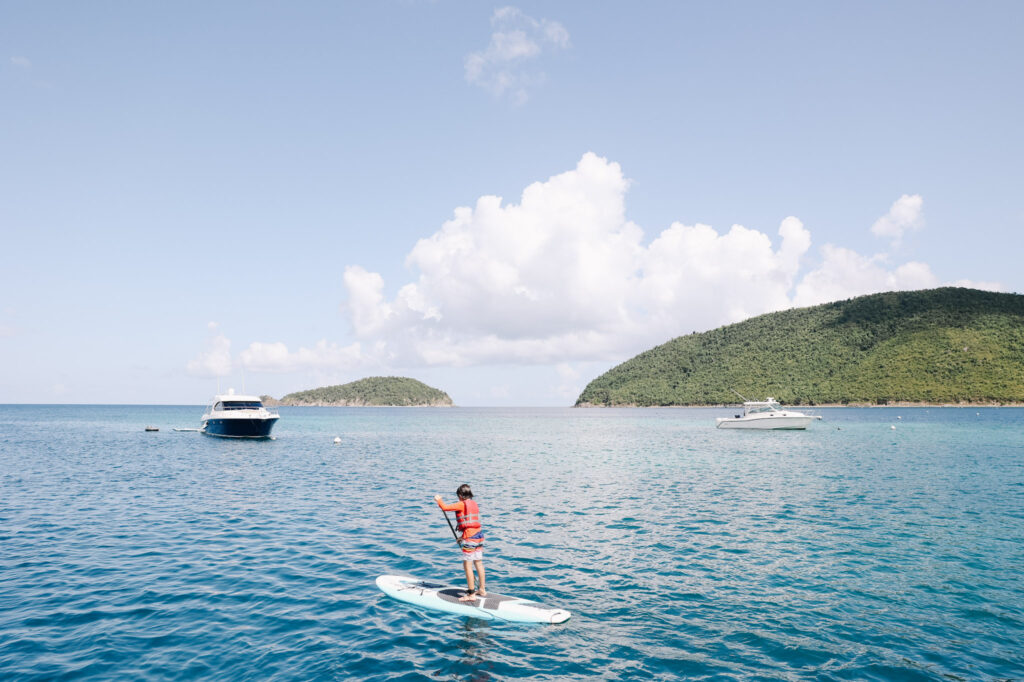
9. Photography in Virgin Islands National Park
- Camera
- 70-200mm lens (for wildlife)
- 24-70mm lens
- Tripod
- ND Filter
- Remote
Enjoy Your Visit to Virgin Islands National Park with Kids!
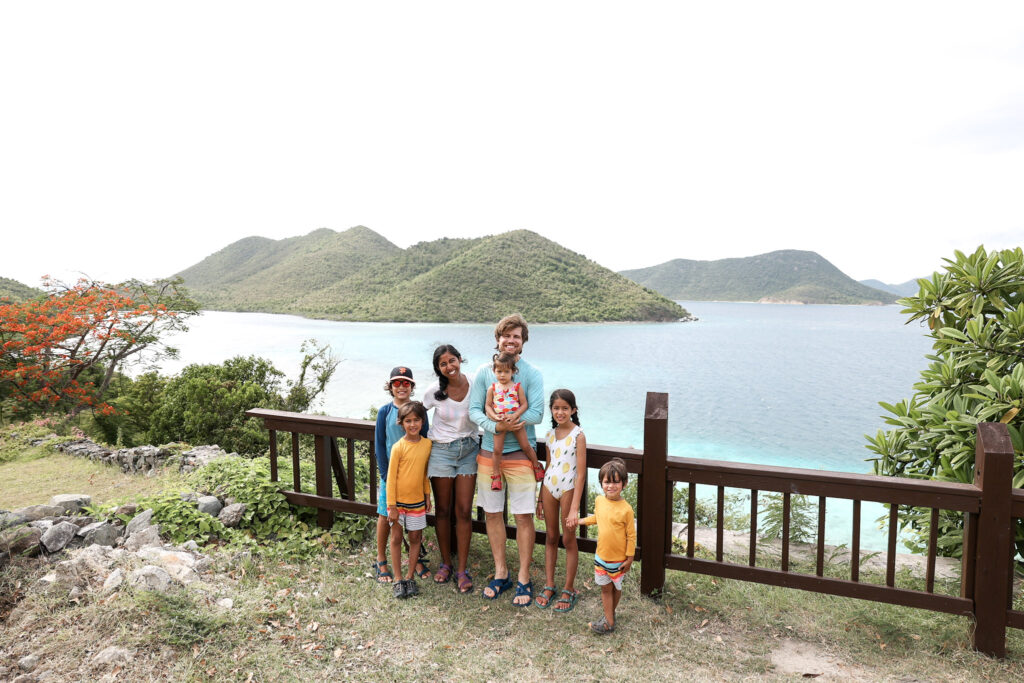
MORE POSTS
IF YOU LIKED THIS POST ABOUT THE BEST THINGS TO DO IN VIRGIN ISLANDS NATIONAL PARK, YOU MIGHT LIKE THESE POSTS TOO:
- Things to do in National Parks: Activities That Don’t Involve Hiking
- Best US National Parks By Month
- 10 Surprisingly Affordable Destinations for Family Holidays
